According to the legal limits and KY water utility companies, most of Kentucky’s tap water quality is generally safe, thanks to strict regulations by the Environmental Protection Agency (EPA) and the Kentucky Division of Water. These agencies ensure the water meets safety standards. Yet, some contaminants may exceed recommended levels, and water quality can differ across the state.
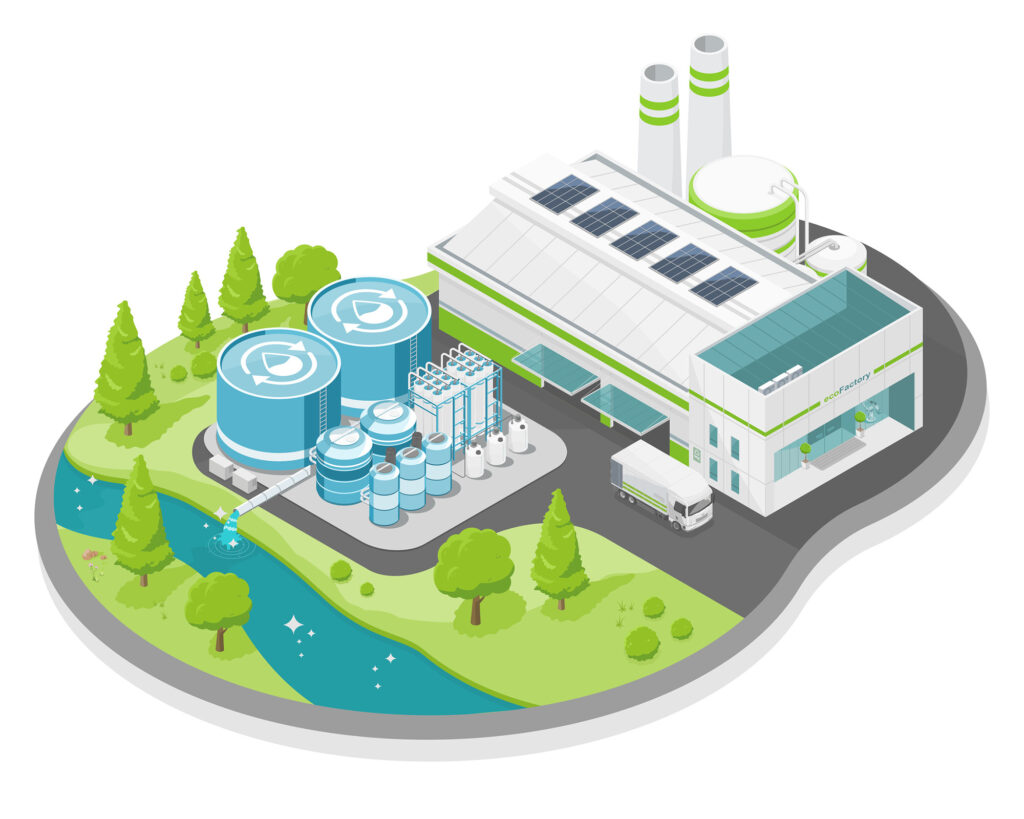
The Environmental Working Group (EWG) is a non-profit, non-partisan organization focused on protecting human health and the environment through research and advocacy. They work to empower people to make informed choices and live healthier lives by addressing issues related to chemicals, food, and water. EWG’s drinking water quality report for Kentucky shows results of tests conducted by the water utilities in Kentucky and provided to EWG by the Kentucky Department for Environmental Protection.
According to EWG.org, the current state of Kentucky’s drinking water is as follows:
- Contaminants found: 114
- Utility Companies Serves: 4,495,000
- Data from: 2013-2024
- Utility Companies reported: 375
Here are the contaminants found in KY’s Drinking Water that are above Health Guidelines:
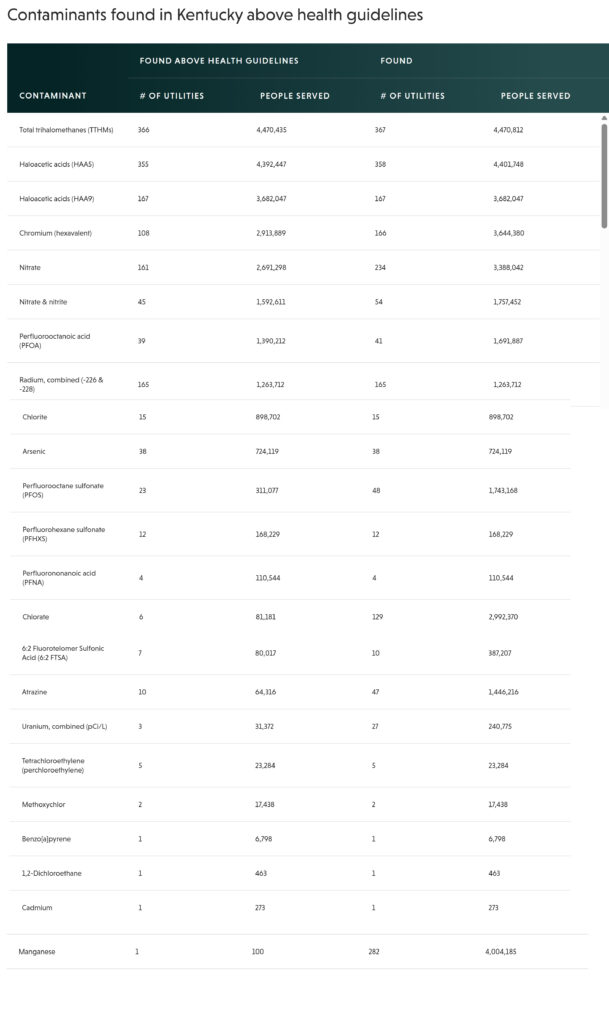
According to EWG, here are the contaminants found in KY’s drinking water that are above the legal limits:

Legal limit does not necessarily equal safe.
- Getting a passing grade from the federal government does not mean the water meets the latest health guidelines.
- Legal limits for contaminants in tap water have not been updated in almost 20 years.
- The best way to ensure clean tap water is to keep pollution out of source water in the first place.
The report for Lexington-Fayette County Water
The EWG.org breaks it down by county or utility so that you can see which contaminants are above the health guidelines and/or legal limits for your region’s water. For example, here is the Kentucky American Water’s report (which serves the Lexington-Fayette region).
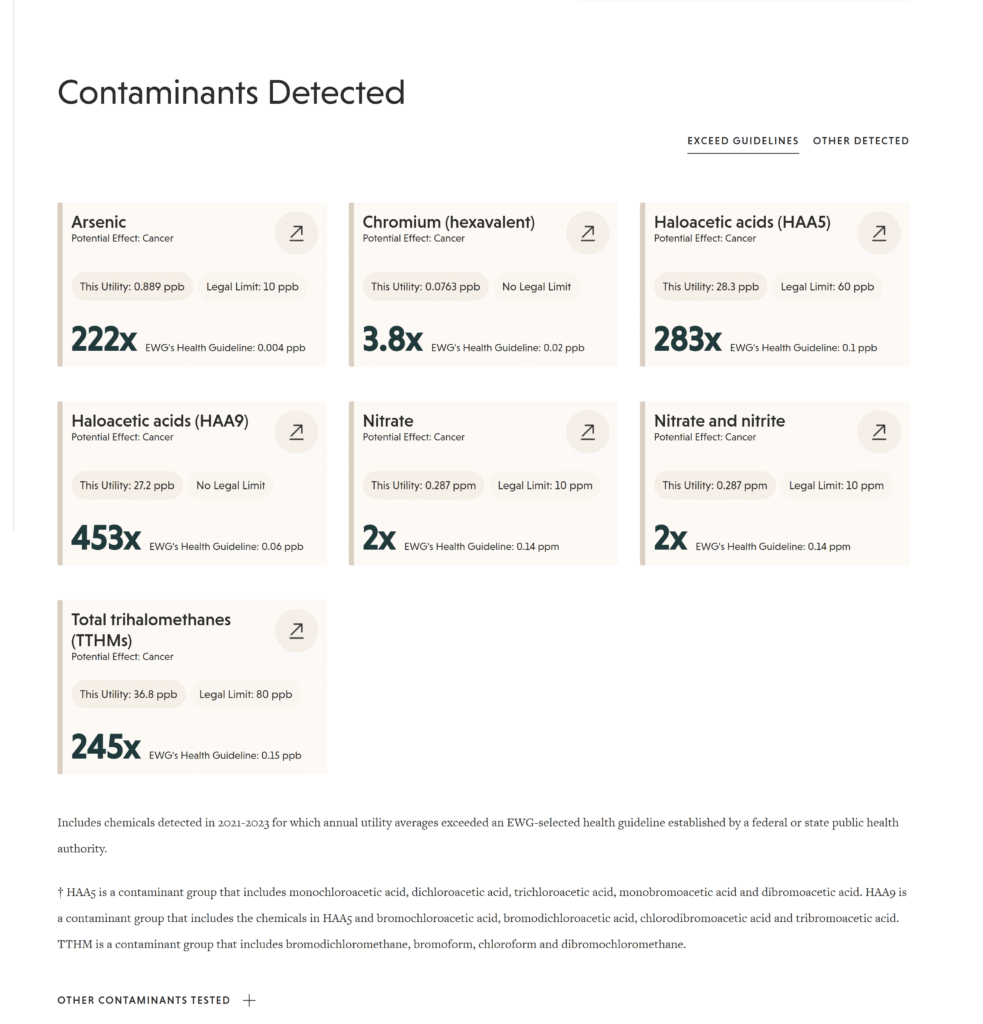
As you can see above, some KY Water systems have recorded levels of HAA5, HAA9, TTHM, chromium-6, nitrates, arsenic, and more.
- HAA5 & HAA9: These are considered disinfection byproducts (DBPs) because they are created as a result of the water treatment process, not as naturally occurring substances. Chlorine and chloramine, commonly used disinfectants, react with organic matter (humic acid, for example) in the water. The presence of HAA5 can affect the quality of drinking water and may be a concern for public health due to a Carcinogenic Risk. Some studies have shown that certain HAA5 may pose a cancer risk, especially in laboratory animals, and there is limited evidence of a similar risk in humans.
- HAA5 includes: Monochloroacetic acid, Dichloroacetic acid, Trichloroacetic acid, Monobromoacetic acid, and Dibromoacetic acid.
- HAA9 includes: Bromochloroacetic acid, Bromodichloroacetic acid, Dibromochloroacetic acid, and Tribromoacetic acid
- TTHMs: TTHM stands for Total Trihalomethanes, which are a group of organic compounds formed as byproducts when chlorine or other disinfectants react with organic matter in drinking water. While TTHMs are generally considered safe at levels below the EPA standard, long-term exposure to high levels may be linked to certain health risks, including an increased risk of bladder or colon cancer.
- Chromium-6: Hexavalent chromium (Cr6), a form of chromium, is a water contaminant that can be found in drinking water sources. It is a carcinogen and reproductive toxicant, and exposure can occur through breathing, ingestion, and skin contact. While the EPA classifies Cr6 as a known carcinogen when inhaled, the determination for oral exposure is still under review. Cr6 can enter water from various sources, including industrial discharges and leaching from hazardous waste sites.
- Nitrates: Nitrate in water is a naturally occurring compound of nitrogen and oxygen, typically found in low concentrations in groundwater. While it’s a common part of the human diet, primarily through vegetables like spinach and beets, drinking water contributes a smaller portion to our overall nitrate intake. High nitrate levels in drinking water can be a concern, particularly for infants, as they can lead to a condition called methemoglobinemia, also known as “blue baby syndrome”.
- Arsenic: Arsenic in water refers to the presence of arsenic, a naturally occurring metal-like substance, in drinking water sources like wells or public water systems. Arsenic can be dissolved into groundwater from natural rock formations or through human activities like mining and industrial processes. It is odorless and tasteless, making it difficult to detect without testing. While arsenic is naturally present in small amounts, high levels in drinking water can pose health risks, including skin changes, digestive problems, and an increased risk of certain cancers, like bladder, lung, and skin cancer.
There are just a few of the contaminants found in the Lexington-Fayette County water system above the guidelines. To see your specific area’s water report, go to EWG KY State Water Report by Utilities.
PFA’s in Kentucky Drinking Water Systems
While most of Kentucky’s drinking water is considered generally safe, there’s growing concern over specific contaminants—particularly PFAS (“forever chemicals”) and disinfection byproducts—depending on the region and water system. Kentucky began statewide PFAS testing in 2019. In a sample of 81 community water systems, about half had at least one PFAS detected. Some systems—especially those drawing from the Ohio River near industrial sites—exceeded the proposed EPA threshold of 4 ppt. The highest measured GenX level was 30 ppt. A Louisville tap sample showed 10 different PFAS, totaling 45.2 ppt, with several compounds above health‑based guidance. An estimated 800,000 Kentuckians receive water with detectable PFA.
In 2024, the EPA set new federal PFAS limits (4 ppt for PFOA/PFOS, 10 ppt for others), with phased compliance required by 2029. Kentucky is receiving about $22 million in federal grants to modernize water treatment and address PFAS in small or disadvantaged communities.
What can you do to Remove Contaminants from your Water (at home or business)?
With the EWG Reports comes the recommendation to filter your water, and they have tested 10 Countertop Filter options for a quick and affordable solution. But it requires effort on the part of the home’s residents and family members to keep the countertop pitcher filled and refilled, while also changing the filter every 90 days.

The Countertop Filters have the following limitations:
- Only purify water from one source (usually the kitchen sink).
- Limited capacity to handle contaminants—often just chlorine, taste, and odor.
- Doesn’t protect you when showering, doing laundry, or using water in other parts of the home.
- Filters need to be replaced more frequently (every 2–3 months).
- A countertop filter may still be useful for renters, limited budgets, or when only drinking water filtration is needed.
Installing a whole home filtration system offers a number of significant advantages over a simple countertop filter, especially when you want complete water protection for your household. These advantages include:
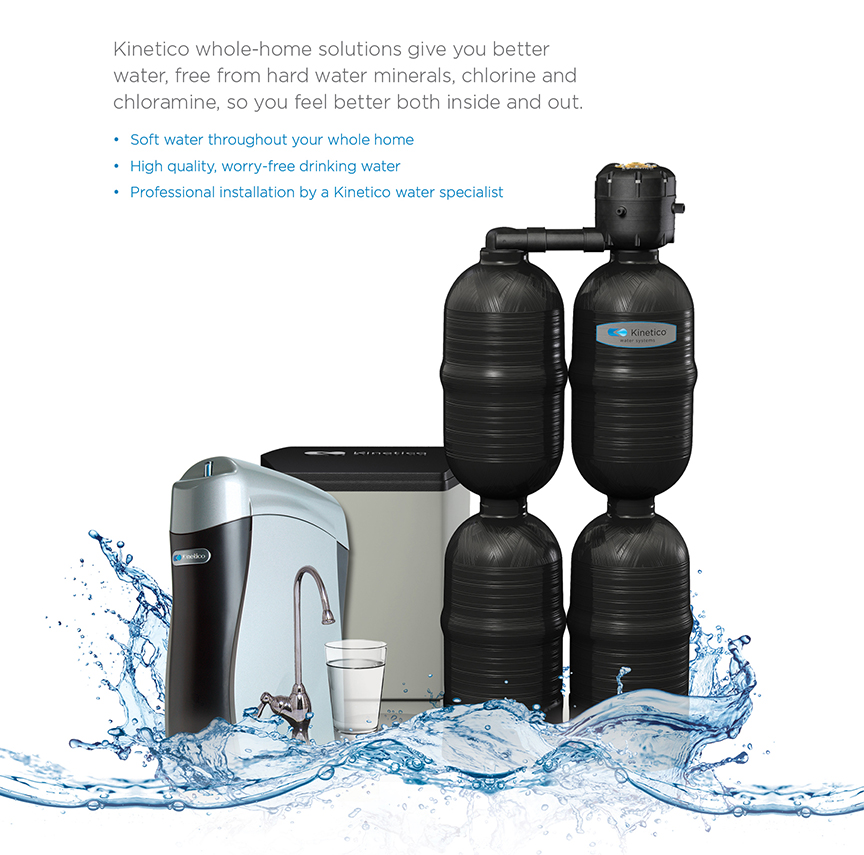
- The whole system will filter all water entering your home—not just what comes from one faucet, thus it protects water used for: Drinking & cooking, Showering & bathing, Laundry & dishwashing, and Brushing teeth.
- You will have healthier skin, hair & lungs, as the whole home filtration removes chlorine, chloramines, and other irritants from bath and shower water; and reduces exposure to volatile chemicals that can be inhaled as steam (e.g., from hot showers).
- You will have better protection against contaminants, since a whole home system can handle a wider range of contaminants, including: Sediment, iron, sulfur, Chlorine, chloramines, VOCs, pesticides, and Kinetico water systems can even reduce PFAS or heavy metals.
- You will have appliance and pipe longevity as a whole filtration system reduces scale and mineral buildup in water heaters, dishwashers, and pipes. It also helps prevent corrosion and extends the life of plumbing and appliances.
- A whole house system offers additional convenience, since there’s no need to refill or replace filters every few weeks like with countertop units. They require less maintenance — typically only periodic cartridge changes.
We recommend the K5 Drinking Water Station
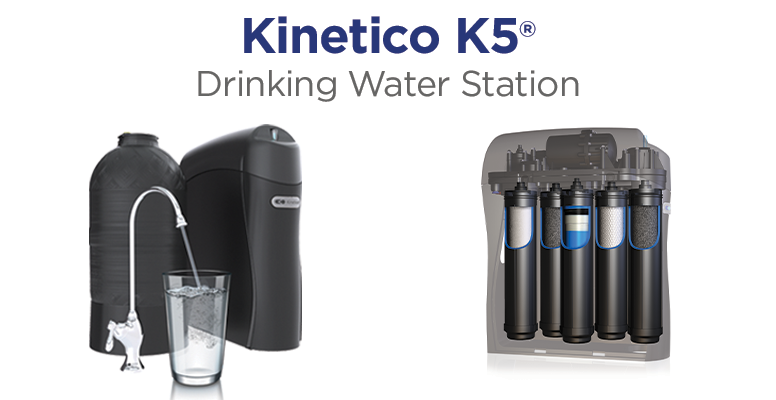
Kinetico designed this state-of-the-art reverse osmosis system to solve even the toughest water quality challenges. The K5 is smartly designed to be convenient and economical, provide an abundant supply of high-quality water, be easy to use and maintain, and provide the best-tasting water. When you own a K5, you know you are doing all you can to provide your family with the highest water quality at the best price.
Alleviate your water worries, today and tomorrow, with clean, crystal clear, worry-free drinking water. Outperforming all others Not only is the Kinetico K5 Drinking Water Station certified to remove more contaminants than any other system, it also offers higher production rates—producing more than 40 gallons of drinking water daily—along with higher, more sustained flow rates made possible by QuickFlo technology.
The K5 significantly reduces more contaminants than any other drinking water treatment unit. The K5 is certified by WQA to NSF/ANSI Standard 58 for PFOS/PFOA removal. Improve your protection by adding the Purefecta Virus/Bacteria Guard, which reduces greater than:
- 99.99% of viruses
- 99.99999% of bacteria
- 99.999% of protozoa/cysts
Before you decide on which water system to install into your home or business, you need to get a free evaluation with a KarSare water professional. Based on the test results and your unique water quality concerns, Kinetico will recommend appropriate water treatment solutions to address any identified issues. These solutions may include water softeners, filtration systems, reverse osmosis systems, or other technologies designed to improve water quality and meet your specific needs.
First Step: Get your Water Tested
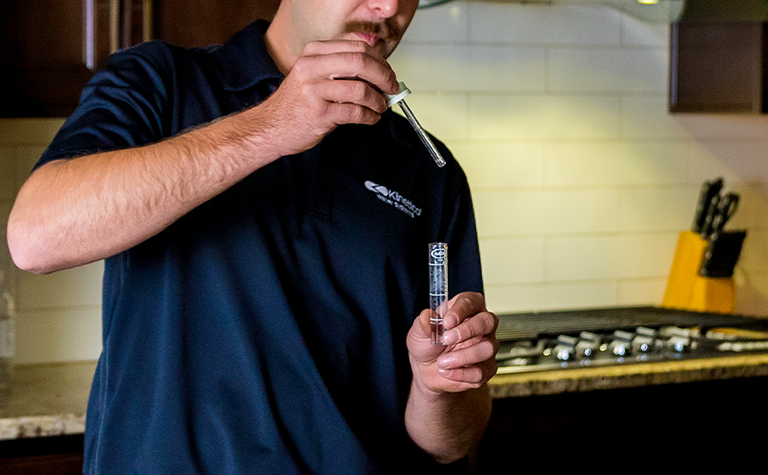
Whether your home’s water is supplied by a municipality or a private well, it is important to understand what is and isn’t in your water. By having your water tested, you will learn about the quality of your water, if any contaminants are present and what water treatment options are available to improve your water.
A great way to learn what is in your water is to have an in-home water test conducted by a certified water professional. Testing the water in your home allows a water professional to check the water at the source, as soon as it comes out of the faucet or spicket. One of our KarSare Water Systems water professional will collect samples from your water source and conduct various tests right in your home, for free. You’ll receive a detailed water analysis as well as a water treatment recommendation to resolve any water problems your test results indicate.







